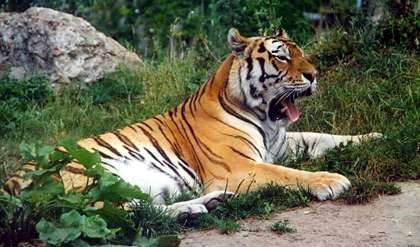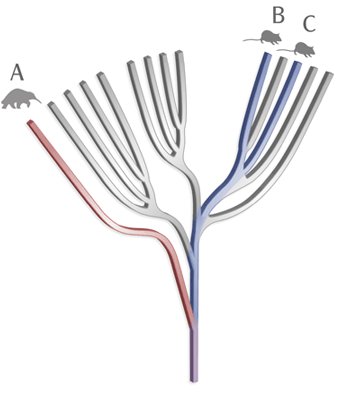|
Chinese Dormouse
The Chinese dormouse or Sichuan dormouse (''Chaetocauda sichuanensis'') is a species of dormouse found in subalpine mixed forests in northern Sichuan, China, where it is known from Jiuzhaigou and Wanglang Nature Reserves. It is known only from two captured female specimens taken in the Wanglang Natural Reserve, and was first described by Wang Youzhi in 1985 and relisted by Corbet and Hill (1991, 1992) under a new genus Genus ( plural genera ) is a taxonomic rank used in the biological classification of living and fossil organisms as well as viruses. In the hierarchy of biological classification, genus comes above species and below family. In binomial nom ... as ''Chaetocauda sichuanensis''. It is currently the only member of the genus ''Chaetocauda''. The two specimens had head and body lengths of 90mm and 91mm and tail lengths of 92mm and 102mm, respectively. They weighed 24.5 and 36.0 g. It is nocturnal and arboreal, nesting in trees around 3 metres above the ground, ... [...More Info...] [...Related Items...] OR: [Wikipedia] [Google] [Baidu] |
Dormouse
A dormouse is a rodent of the family Gliridae (this family is also variously called Myoxidae or Muscardinidae by different taxonomists). Dormice are nocturnal animals found in Africa, Asia, and Europe. They are named for their long, dormant hibernation period of six months or longer. As only one species of dormouse – the hazel dormouse – is native to the United Kingdom, in everyday English usage "dormouse" can refer either to that one species or to the family as a whole. The English name of the species derived from the French ''dormeuse'', and the latter in turn possibly from the Languedocien ''radourmeire''. Etymology Concerning the dormouse's name, etymonline says "long-tailed Old World rodent noted for its state of semi-hibernation in winter, early 15c., possibly from Anglo-French ''dormouse'' 'tending to be dormant' (from stem of ''dormir'' 'to sleep,' see ''dormant''), with the second element mistaken for ''mouse''; or perhaps it is from a Middle English dialectal co ... [...More Info...] [...Related Items...] OR: [Wikipedia] [Google] [Baidu] |
Sichuan
Sichuan (; zh, c=, labels=no, ; zh, p=Sìchuān; alternatively romanized as Szechuan or Szechwan; formerly also referred to as "West China" or "Western China" by Protestant missions) is a province in Southwest China occupying most of the Sichuan Basin and the easternmost part of the Tibetan Plateau between the Jinsha River on the west, the Daba Mountains in the north and the Yungui Plateau to the south. Sichuan's capital city is Chengdu. The population of Sichuan stands at 83 million. Sichuan neighbors Qinghai to the northwest, Gansu to the north, Shaanxi to the northeast, Chongqing to the east, Guizhou to the southeast, Yunnan to the south, and the Tibet Autonomous Region to the west. In antiquity, Sichuan was the home of the ancient states of Ba and Shu. Their conquest by Qin strengthened it and paved the way for Qin Shi Huang's unification of China under the Qin dynasty. During the Three Kingdoms era, Liu Bei's state of Shu was based in Sichuan. The ... [...More Info...] [...Related Items...] OR: [Wikipedia] [Google] [Baidu] |
China
China, officially the People's Republic of China (PRC), is a country in East Asia. It is the world's most populous country, with a population exceeding 1.4 billion, slightly ahead of India. China spans the equivalent of five time zones and borders fourteen countries by land, the most of any country in the world, tied with Russia. Covering an area of approximately , it is the world's third largest country by total land area. The country consists of 22 provinces, five autonomous regions, four municipalities, and two Special Administrative Regions (Hong Kong and Macau). The national capital is Beijing, and the most populous city and financial center is Shanghai. Modern Chinese trace their origins to a cradle of civilization in the fertile basin of the Yellow River in the North China Plain. The semi-legendary Xia dynasty in the 21st century BCE and the well-attested Shang and Zhou dynasties developed a bureaucratic political system to serve hereditary monarchies, or dyna ... [...More Info...] [...Related Items...] OR: [Wikipedia] [Google] [Baidu] |
Jiuzhaigou
Jiuzhaigou (; ) is a nature reserve and national park located in the north of Sichuan Province in southwestern China. A long valley running north to south, Jiuzhaigou was inscribed by UNESCO as a World Heritage Site in 1992 and a World Biosphere Reserve in 1997. It belongs to the category V (Protected Landscape) in the IUCN system of protected area categorization. The Jiuzhaigou valley is part of the Min Mountains on the edge of the Tibetan Plateau and stretches over . It is known for its many multi-level waterfalls, colorful lakes, and snow-capped peaks. Its elevation ranges from . History Jiuzhaigou (literally "Nine Settlement Valley") takes its name from the nine Tibetan settlements along its length. The remote region was inhabited by various Tibetan and Qiang peoples for centuries. Until 1975 this inaccessible area was little known. Extensive logging took place until 1979, when the Chinese government banned such activity and made the area a national park in 1982. An Admi ... [...More Info...] [...Related Items...] OR: [Wikipedia] [Google] [Baidu] |
Genus
Genus ( plural genera ) is a taxonomic rank used in the biological classification of extant taxon, living and fossil organisms as well as Virus classification#ICTV classification, viruses. In the hierarchy of biological classification, genus comes above species and below family (taxonomy), family. In binomial nomenclature, the genus name forms the first part of the binomial species name for each species within the genus. :E.g. ''Panthera leo'' (lion) and ''Panthera onca'' (jaguar) are two species within the genus ''Panthera''. ''Panthera'' is a genus within the family Felidae. The composition of a genus is determined by taxonomy (biology), taxonomists. The standards for genus classification are not strictly codified, so different authorities often produce different classifications for genera. There are some general practices used, however, including the idea that a newly defined genus should fulfill these three criteria to be descriptively useful: # monophyly – all descendants ... [...More Info...] [...Related Items...] OR: [Wikipedia] [Google] [Baidu] |
IUCN
The International Union for Conservation of Nature (IUCN; officially International Union for Conservation of Nature and Natural Resources) is an international organization working in the field of nature conservation and sustainable use of natural resources. It is involved in data gathering and analysis, research, field projects, advocacy, and education. IUCN's mission is to "influence, encourage and assist societies throughout the world to conserve nature and to ensure that any use of natural resources is equitable and ecologically sustainable". Over the past decades, IUCN has widened its focus beyond conservation ecology and now incorporates issues related to sustainable development in its projects. IUCN does not itself aim to mobilize the public in support of nature conservation. It tries to influence the actions of governments, business and other stakeholders by providing information and advice and through building partnerships. The organization is best known to the wider ... [...More Info...] [...Related Items...] OR: [Wikipedia] [Google] [Baidu] |
Dormice
A dormouse is a rodent of the family Gliridae (this family is also variously called Myoxidae or Muscardinidae by different taxonomists). Dormice are nocturnal animals found in Africa, Asia, and Europe. They are named for their long, dormant hibernation period of six months or longer. As only one species of dormouse – the hazel dormouse – is native to the United Kingdom, in everyday English usage "dormouse" can refer either to that one species or to the family as a whole. The English name of the species derived from the French ''dormeuse'', and the latter in turn possibly from the Languedocien ''radourmeire''. Etymology Concerning the dormouse's name, etymonline says "long-tailed Old World rodent noted for its state of semi-hibernation in winter, early 15c., possibly from Anglo-French ''dormouse'' 'tending to be dormant' (from stem of ''dormir'' 'to sleep,' see ''dormant''), with the second element mistaken for ''mouse''; or perhaps it is from a Middle English dialectal co ... [...More Info...] [...Related Items...] OR: [Wikipedia] [Google] [Baidu] |
Mammals Of Asia
All of the animals living in Asia and its surrounding seas and islands are considered the fauna of Asia. Since there is no natural biogeographic boundary in the west between Europe and Asia. The term "fauna of Asia" is somewhat elusive. Temperate Asia is the eastern part of the Palearctic realm (which in turn is part of the Holarctic), and its south-eastern part belongs to the Indomalayan realm (previously called the ''Oriental region''). Asia shows a notable diversity of habitats, with significant variations in rainfall, altitude, topography, temperature and geological history, which is reflected in its richness and diversity of animal life. Origins of Asian wildlife The formation of the Asian fauna began in the Mesozoic with the splitting of Laurasian supercontinent. Asia blends elements from both ancient supercontinents of Laurasia and Gondwana. Gondwanian elements were introduced from Africa and by India, which detached from Gondwana approximately 90 MYA, carrying its Gondwana ... [...More Info...] [...Related Items...] OR: [Wikipedia] [Google] [Baidu] |
EDGE Species
Evolutionarily Distinct and Globally Endangered (EDGE) species are animal species which have a high 'EDGE score', a metric combining endangered conservation status with the genetic distinctiveness of the particular taxon. Distinctive species have few closely related species, and EDGE species are often the only surviving member of their genus or even higher taxonomic rank. The extinction of such species would therefore represent a disproportionate loss of unique evolutionary history and biodiversity. Some EDGE species, such as elephants and pandas, are well-known and already receive considerable conservation attention, but many others, such as the vaquita (the world's rarest cetacean) the bumblebee bat (arguably the world's smallest mammal) and the egg-laying long-beaked echidnas, are highly threatened yet remain poorly understood, and are frequently overlooked by existing conservation frameworks. The Zoological Society of London launched the EDGE of Existence Programme in 2007 to ... [...More Info...] [...Related Items...] OR: [Wikipedia] [Google] [Baidu] |





